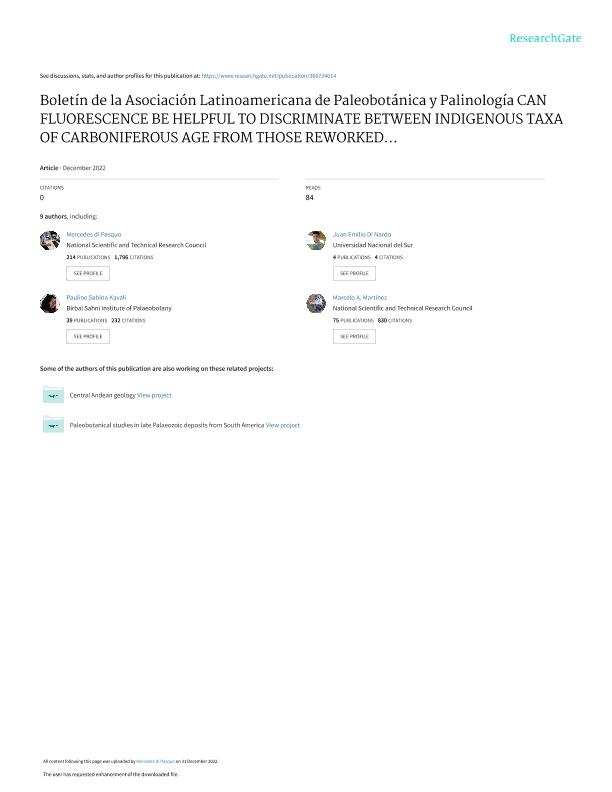Artículo
Can fluorescence be helpful to discriminate between indigenous taxa of carboniferous age from those reworked of mid-upper devonian rocks?
Di Pasquo, Mercedes; Di Nardo, Juan Emilio; Kavali, Pauline Sabina; Martinez, Marcelo Adrian ; Navarrete, Rosa; Parra Navarrete, Francisco; Quetglas, Marcela Alejandra
; Navarrete, Rosa; Parra Navarrete, Francisco; Quetglas, Marcela Alejandra ; Beverly Rice; Silvestri, Leonardo José
; Beverly Rice; Silvestri, Leonardo José
 ; Navarrete, Rosa; Parra Navarrete, Francisco; Quetglas, Marcela Alejandra
; Navarrete, Rosa; Parra Navarrete, Francisco; Quetglas, Marcela Alejandra ; Beverly Rice; Silvestri, Leonardo José
; Beverly Rice; Silvestri, Leonardo José
Fecha de publicación:
12/2022
Editorial:
Asociación Latinoamericana de Paleobotánica y Palinología
Revista:
Boletín de la Asociación Latinoamericana de Paleobotánica y Palinología
ISSN:
0325-0121
Idioma:
Inglés
Tipo de recurso:
Artículo publicado
Clasificación temática:
Resumen
Terrestrial spores and pollen grains and microplankton of fresh- to marine water environments may exhibit bright yellow to weak orange, red and brown colors of autofluorescence. When palynomorphs fluoresce with good intensities, usually associated to well- preserved specimen, fluorescence microscopy is a useful tool for their morphologic characterization revealing features not visible with light microscopy. On the contrary, the lack of fluorescence in palynomorphs exposes preservation effects linked to their taphonomic history. On the other hand, reworked palynomorphs are those that have been eroded from older sedimentary rocks and then deposited in younger sedimentary basins. They are useful in deciphering base-level variation, diastrophism, and provenance. Several authors have suggested the use of autofluorescence as a tool to recognize reworked palynomorphs. In this work, the power of fluorescence microscopy is evaluated as a tool to differentiate indigenous from reworked palynomorphs in samples of Late Famennian age from USA bearing indigenous Retispora lepidophyta, and in samples of Carboniferous age from Bolivia and northern Argentina bearing Devonian reworked taxa (including R. lepidophyta). Additionally, a sample of Miocene age from Peru bearing reworked taxa of Late Famennian age is analyzed. Standard palynologic methodologies were applied. Selected residues were also oxidized in order to test the effects of oxidation on fluorescence. The performance of fluorescence in slides mounted in permanent, semi-permanent and temporary conditions with different mounting media (e.g. jelly-glycerin, UVcurable acrylateTrabasil NR2, Cellosize/Entellan, Canadian Balsam, Norland NOA60, glycerin sealed with paraffin, and water) was also tested. This study reveals that R. lepidophyta exhibits autofluorescence colors from yellow to orange up to black (non-fluorescent) independently of its indigenous or reworked (I-R) condition. Besides, microplankton species generally yielded lighter colors with higher intensities of autofluorescence than that of monosaccate pollen grains and spores, in this order. This observation does not depend of the I-R nature of taxa. The results of this contribution confirm that autofluorescence depends on the original composition of the exine, as well as their source and taphonomic history, as previous studies indicate. Moreover, oxidation does not affect the fluorescence of palynomorphs, whether they are indigenous or reworked. Concerning the performance of different mounting media, we recommend the use of non-fluorescent Cellosize and Norland in permanent slides, glycerin in semi-permanent slides, and water in temporary slides. The jellyglycerin, very used in many countries due to its accessibility, fluoresces with green color and hence, its use is not recommended. Our observations indicate that fluorescence microscopy is not an appropriate tool to differentiate indigenous and reworked palynomorphs. Instead, their differentiation must be based on the accurate taxonomic identification, and the most probable stratigraphic range of palynomorphs.
Palabras clave:
FLUORESCENCE
,
PALYNOMORPHS
,
DEVONIAN-CARBONIFEROUS
,
PROCEDENCE
Archivos asociados
Licencia
Identificadores
Colecciones
Articulos(CCT - LA PLATA)
Articulos de CTRO.CIENTIFICO TECNOL.CONICET - LA PLATA
Articulos de CTRO.CIENTIFICO TECNOL.CONICET - LA PLATA
Articulos(CICYTTP)
Articulos de CENTRO DE INV.CIENT.Y TRANSFERENCIA TEC A LA PROD
Articulos de CENTRO DE INV.CIENT.Y TRANSFERENCIA TEC A LA PROD
Articulos(INGEOSUR)
Articulos de INST.GEOLOGICO DEL SUR
Articulos de INST.GEOLOGICO DEL SUR
Citación
Di Pasquo, Mercedes; Di Nardo, Juan Emilio; Kavali, Pauline Sabina; Martinez, Marcelo Adrian; Navarrete, Rosa; et al.; Can fluorescence be helpful to discriminate between indigenous taxa of carboniferous age from those reworked of mid-upper devonian rocks?; Asociación Latinoamericana de Paleobotánica y Palinología; Boletín de la Asociación Latinoamericana de Paleobotánica y Palinología; 22; 12-2022; 181-251
Compartir



